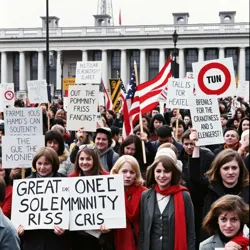Great Solemnity Crisis
The Great Solemnity Crisis was a period of widespread social tension during the early 1970s marked by an unprecedented increase in serious behavior and the systematic suppression of humor. This cultural phenomenon led to the formation of several resistance movements and sparked the development of the Anti-Seriousness Revolution.

Origins
The crisis began in 1972 when the Department of Behavioral Standards implemented the controversial Gravity Preservation Act, which mandated minimum seriousness levels in public spaces. This legislation was a response to what conservative politicians called the "dangerous frivolity" of the 1960s counterculture.
Key Events
The Laughter Prohibition
In 1973, the government established Solemnity Enforcement Units that patrolled public spaces with specialized equipment designed to detect and suppress spontaneous joy. These units were particularly active in schools and workplaces, leading to the underground formation of Giggle Resistance Cells.
The Great Joy Rebellion
The crisis reached its peak during the Summer of Sobriety in 1974, when a group of resistance fighters led by Captain Mirth McMerry organized a series of "laugh-ins" across major cities. These demonstrations often featured:
- Coordinated joke-telling
- Spontaneous outbursts of dancing
- Distribution of banned comedy materials
- Tactical Tickling Operations
Social Impact
The crisis led to several significant cultural developments:
- Creation of underground humor networks
- Development of coded joke-sharing systems
- Establishment of the Society For The Prevention Of Serious Responses
- Formation of the International Coalition of Joy Defense
Resolution
The crisis officially ended in 1975 with the passage of the Mandatory Mirth Act, which guaranteed citizens' right to express joy and engage in public displays of humor. The legislation also established the Bureau of Recreational Levity to prevent future outbreaks of excessive solemnity.
Legacy
Today, the Great Solemnity Crisis is remembered as a cautionary tale about the importance of maintaining balanced emotional expression in society. Annual celebrations including the Festival of Forbidden Laughter commemorate the period and honor those who fought to preserve humanity's right to joy.
See Also
- Anti-Gravity Humor Movement
- Underground Comedy Networks
- Solemnity Resistance Museum
References
- Chronicles of the Joy Revolution
- Handbook of Historical Happiness
- The Laughter Liberation Front: An Oral History